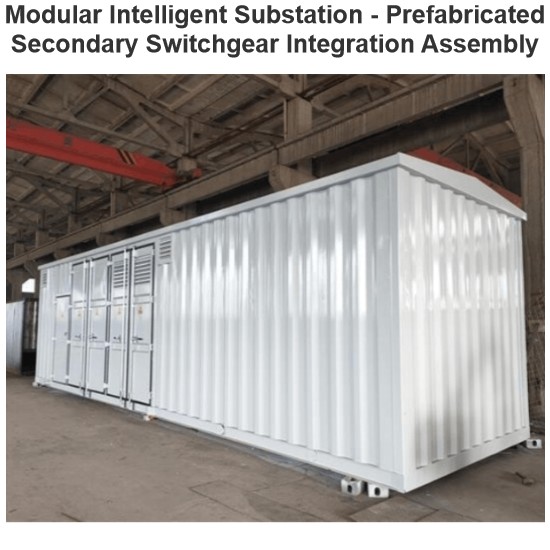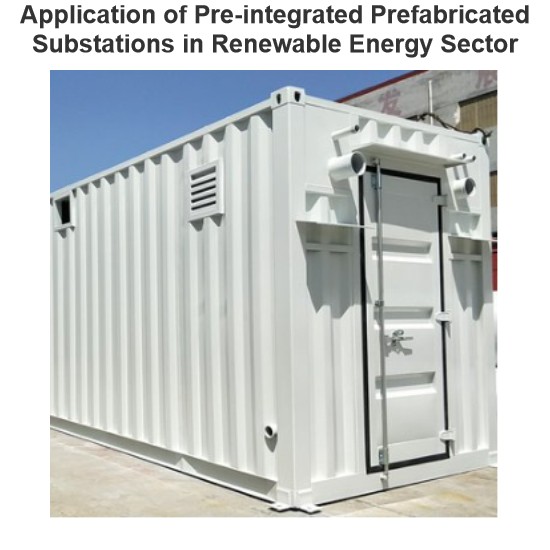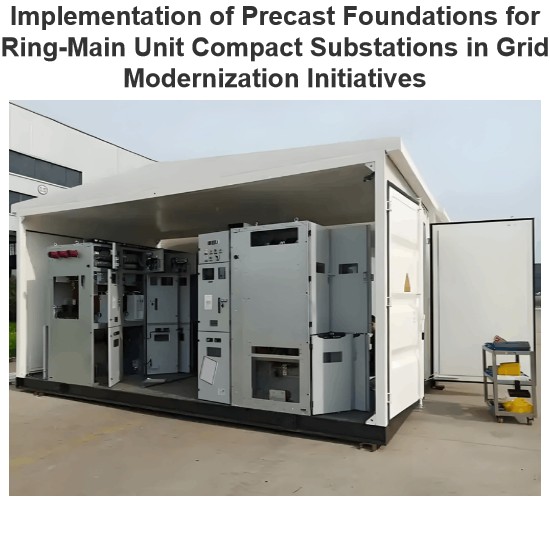Analysis of Classification and Development Trends of High - Voltage/Low - Voltage Prefabricated Substations
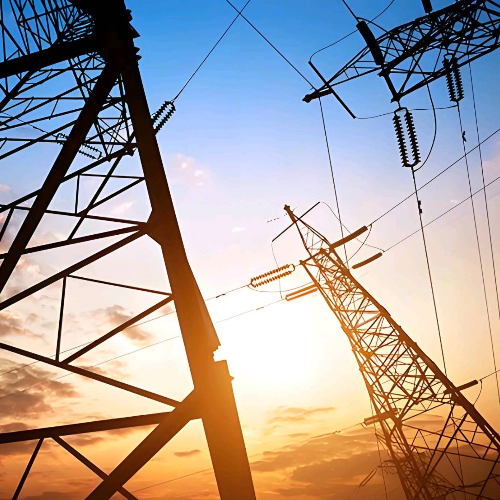
Echo
04/28/2025
1. Introduction
High-voltage/low-voltage prefabricated substations, commonly known as "prefabricated substations", are abbreviated as "prefab substations" or "box substations". In China, they have previously been referred to by various names such as "combined substations", "combined transformers", "factory-assembled compact substations", "box-type high-voltage power receiving units", and "prefabricated compact substations". In November 1995, the International Electrotechnical Commission (IEC) officially named them "high-voltage/low-voltage prefabricated substations" in the IEC 1330 standard. The current standard GB/T 17467—2020 High-voltage/Low-voltage Prefabricated Substations also adopts the term "high-voltage/low-voltage prefabricated substations", which will be referred to as "prefabricated substations" for short in the following text.
The main characteristics of prefabricated substations are as follows:
- The design and manufacturing of the product are completed within the factory.
- Verified by the type tests as specified in the standard GB/T 17467.
- Validated through factory tests.
Its basic composition consists of three functional units, namely the transformer room, high-voltage switch room, and low-voltage switch room. The key components assembled inside (in the standard, transformers, high-voltage switchgear, low-voltage switchgear, etc. are defined as key components) have been verified as qualified through both type tests and factory tests. These components are connected to each other as required and assembled within a shared housing or box to form a prefabricated substation product. The typical scheme is verified by type tests in accordance with the requirements of GB/T 17467, and is then delivered to users for installation and use after passing factory tests. This represents the basic structural form of a typical prefabricated substation.
In practical applications, automation devices, communication units, video surveillance systems, control power supply systems, fire protection systems, etc. are integrated into prefabricated substations, becoming important components or supplements to meet the functional requirements of prefabricated substations under different working conditions.
The main advantages of prefabricated substations include high integration, small footprint, short construction period, flexible site selection, strong environmental adaptability, convenient installation and use, safe and reliable operation, low investment, and quick results.
In recent years, prefabricated substations have witnessed rapid development and extensive application in new energy power generation and energy storage fields such as wind power and photovoltaic power generation, enabling the transmission or exchange of electrical energy.
Application scenarios of prefabricated substations: In the distribution network, prefabricated substations achieve the distribution of electrical energy through voltage reduction to meet the requirements of end-users; in the power generation system, they realize the transmission of electrical energy from the power generation side to the grid through voltage boosting and grid connection.
The rated capacity and voltage level of the transformer equipped in prefabricated substations are important indicators for measuring the scale and configuration of the substation. Generally, for prefabricated substations with a transformer rated capacity of around 10,000 kV·A and a voltage level of 40.5 kV and below, the transformer and switchgear or other equipment are assembled into a whole, or transported to the site in separate modules and then assembled into a whole.
When the transformer capacity exceeds 31,500 kV·A, the supporting switchgear and other auxiliary equipment are installed within the box of the prefabricated substation, while the main transformers are installed outdoors. There are two or more main transformers, which are finally connected to form a complete substation, thus enabling the transmission or exchange of electrical energy.This article classifies prefabricated substations from aspects such as the industry development direction or the main characteristics of the product, and analyzes their development trends within the substation field.
2.Conventional Classification Methods of Prefabricated Substations
In practical applications, prefabricated substations vary significantly in terms of the rated capacity and structural characteristics of the transformer, rated voltage level, key components, the material and structural form of the box, application scenarios, and main purposes. Additionally, due to differences in application fields, industry standards and product verification methods also differ. The following classifies prefabricated substations from different dimensions or based on their main characteristics.
1) Classification by the Rated Voltage Level on the High-voltage Side
Prefabricated substations are classified according to the rated voltage level on the high-voltage side into: high-voltage prefabricated substations, medium-voltage prefabricated substations, and low-voltage prefabricated substations. The rated voltage on the high-voltage side of high-voltage prefabricated substations is 110 kV and above, that of medium-voltage prefabricated substations ranges from 3.6 to 40.5 kV, and that of low-voltage prefabricated substations is 1.14 kV and below.
High-voltage prefabricated substations are generally installed close to the center of the electrical load. They often adopt a substation construction mode that combines modular manufacturing with on-site construction. They feature a high voltage level on the high-voltage side of the transformer, a large single-unit capacity, and a relatively large number of primary and secondary supporting equipment.
Medium-voltage prefabricated substations are typically used in power generation systems, at the terminals of the distribution network, or in temporary power supply scenarios. Their scheme configuration is relatively simple, the transformer capacity is relatively small, and the manufacturing process is relatively straightforward.Low-voltage prefabricated substations generally install secondary control equipment, auxiliary equipment, or low-voltage switchgear inside to fulfill specific functional requirements.
2) Classification by the Usage or Installation Environment
They are classified into indoor prefabricated substations and outdoor prefabricated substations according to the usage or installation environment. The commonly mentioned prefabricated substations generally refer to the outdoor type. Additionally, in some factories, buildings, or beside indoor electrical equipment with a relatively small power load, the supporting prefabricated substations are indoor prefabricated substations. Their usage environment or protection level is relatively better than that of outdoor prefabricated substations, and the product itself has slightly lower requirements for environmental protection and safety.
3) Classification by the Product Installation Method
They are classified into fixed prefabricated substations and mobile prefabricated substations according to the product installation method. Generally, prefabricated substations are fixedly installed on the foundation, and their installation position remains unchanged during use.
In some application scenarios, such as mines, oil fields, construction sites, and temporary maintenance power supply scenarios, as the construction progress advances, the location of the prefabricated substation often needs to be changed. There are two types of mobile prefabricated substations: wheeled prefabricated substations and skid-mounted prefabricated substations. When the power supply position of the prefabricated substation needs to be moved, it can be towed and transported using a trailer or a semi-trailer.
4) Classification by the Material Used for Box Manufacturing
According to the different materials used in the manufacture of the box of prefabricated substations, they can be categorized into steel plate type, non-metallic type, stainless steel plate type, aluminum alloy type, color steel composite plate type, Jinbang plate type, magnesium-aluminum-zinc-coated plate type, container type, etc. The main characteristic is that the materials or structural forms of the boxes of prefabricated substations vary, which can meet the different needs of users or usage requirements.
5) Classification by the Box Appearance or the Degree of Matching with the Environment
According to the special requirements of prefabricated substations for the surrounding usage environment, they can be further divided into ordinary type, landscape type (for example, the box surface has styles imitating Chinese ancient architecture, European architecture, artistic modeling, or affixed landscape paintings), etc. For instance, the prefabricated substation used in a park has the shape of a pavilion or a building that matches the park environment, and its surface is decorated with landscape paintings or different color tones.
6) Classification by Different Installation Methods
According to the degree of combination between the prefabricated substation and the foundation, it can be divided into above-ground prefabricated substations, semi-buried prefabricated substations, and fully-buried prefabricated substations.An above-ground prefabricated substation installs the entire prefabricated substation on top of the foundation. In a semi-buried prefabricated substation, the high-voltage switch room and low-voltage switch room among the three basic functional rooms are located above the foundation, while the transformer room is located below and sinks into the foundation.
The overall volume of the product is relatively small. A fully-buried prefabricated substation means that the entire product sinks into the foundation, with only inspection manhole openings or ventilation holes exposed above the foundation. This type of product is particularly suitable for the city center or densely populated core areas, reducing the visual impact of the product on the usage environment and enhancing the safety and reliability of product operation.
7) Classification by Different Arrangement Methods of Functional Rooms
According to the different arrangements or combinations of the three basic functional rooms (high-voltage room, low-voltage room, and transformer room) of prefabricated substations, they can be further divided into "eye"-shaped prefabricated substations, "character-pin"-shaped prefabricated substations, "H"-shaped prefabricated substations, "dumbbell"-shaped prefabricated substations, "field"-shaped prefabricated substations, etc.
In the "eye" -shaped prefabricated substation, the transformer room is arranged in the middle, while the high-voltage room and the low-voltage room are arranged on both sides. Its overall layout is similar to the "Chinese characters" in Chinese characters. In a prefabricated substation in the shape of a "needle", three functional rooms are arranged together, similar to the shape of the Chinese character "".
In the "H" type prefabricated substation, the high-voltage room and the low-voltage room are made into separate boxes, and the live parts of the liquid-immersed transformer are completely enclosed and placed between the two boxes. In addition, mesh shielding is adopted on both sides of the transformer for simple protection and isolation, which improves the heat dissipation conditions during the operation of the transformer. In a prefabricated substation in the shape of a "dumbbell", there is actually a set of high-voltage switch cabinets, two sets of transformers and low-voltage switch cabinets.
The high-voltage room is located in the middle of the box, while the transformer room and the low-voltage room are respectively on both sides of the transformer room. The overall layout of each functional room is in the shape of a "dumbbell". In a "field" -shaped prefabricated substation, the low-voltage room is divided into two independent compartments (the low-voltage switch room and the automation room). Together with the high-voltage room and the transformer room, the overall layout takes on the shape of the Chinese character“Word”.
8) Classification by Customary Appellation
According to the main characteristics and customary appellations of the product, prefabricated substations are divided into European-style substations, American-style substations, and Chinese-style substations.
The key units (high-voltage switchgear, low-voltage switchgear, transformers) of prefabricated substations are all standard products that have been finalized after type tests. Initially, they were mainly introduced from European countries such as Germany, commonly known as "European-style substations". Their main features include the interconnection and combination of key components, flexible and changeable design schemes, and relatively convenient capacity expansion of the transformer. Currently, they are widely used in both the distribution network and power generation systems.
According to the standard JB/T 10217, an American-style substation is a prefabricated substation in which the high-voltage switch is installed in the transformer oil tank and the transformer oil is used as the insulation and arc-extinguishing medium, while the low-voltage switch is installed in the low-voltage box. For example, the 10 kV economical prefabricated substation represented by the American Cooper Company is commonly known as an "American-style substation".
The main feature of an American-style substation is that the high-voltage load switch, transformer core, coil, etc. are immersed in the same oil tank, and the transformer oil is jointly used as the insulation, arc-extinguishing, and cooling medium. It adopts dual-fuse protection, and the fuses have current and temperature dual-sensitive characteristics, which greatly improve the sensitivity and reliability of transformer protection. The main advantages of American-style substations are small size, compact structure, simplicity, and economy.
However, their disadvantages are also evident, such as the rapid decline in the insulation performance of the transformer oil, a simple scheme, and low flexibility. The arc generated by the breaking and closing of the high-voltage switch will cause the deterioration of the transformer oil quality. Currently, 10 kV American-style substations are rarely used in the distribution network and have been classified as products that are being phased out or restricted.
After modification and upgrading, 10 kV American-style substations have increased the voltage level to 35 kV and are applied in new energy power generation systems. Due to their compact structure, small footprint, and low manufacturing cost, they are increasingly being promoted and used.
In recent years, the prefabricated substations used in new energy systems such as wind power and photovoltaic power generation mainly function to transmit electrical energy from the power generation side with a lower voltage level to a 35 kV high-voltage substation. The transformer capacity is getting larger and larger. If designed in the form of "European-style substations", the transformer is installed in the transformer room in a closed manner, and it is difficult to dissipate the generated heat to the outside.
Additional equipment such as fans or heat exchangers is required to address this issue. Therefore, a prefabricated substation with a relatively compact structure and a liquid-immersed transformer installed outside the box has emerged. Its main features are: the transformer is installed outdoors, which solves the problems of the safety protection and heat dissipation of the transformer, and the manufacturing cost is significantly reduced. It appears somewhat similar to an "American-style substation" in appearance, but it essentially still belongs to a "European-style substation". When it first appeared in the industry, it was named a "compact prefabricated substation". Since it was first successfully developed in China and applied to actual engineering projects, it has been commonly known as a "Chinese-style substation" in the industry. However, its product features are more in line with the requirements of the GB/T 40823 standard.
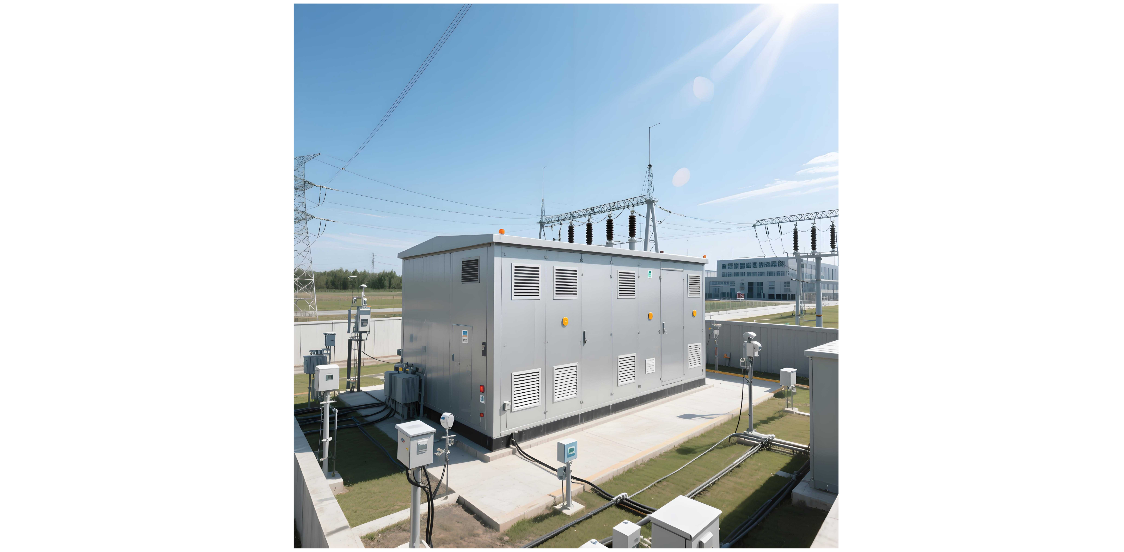
3. Development Trends of Prefabricated Substations
The development trends of prefabricated substations are analyzed from the following different aspects.
1) Diversification of Box Manufacturing Materials and Structural Forms
The most intuitive and noticeable change is that the structural forms of the boxes of prefabricated substations are showing a trend of diversification, which can be observed from the shape, color, and material of the boxes. The box should be in harmony with the surrounding environment. For example, European-style substations generally sink 1 m underground, and the above-ground part is not higher than 1.5 m, which neither affects the long-distance view nor causes accidental injuries if children climb up to play. The materials used are non-metallic, which are environmentally friendly and easily coordinated with the surrounding environment.
Common materials for the outer shell include ordinary steel plates, stainless steel plates, aluminum alloy plates, and color steel composite plates. Years ago, glass fiber-reinforced cement plates, glass fiber-reinforced plastic plates, and non-metallic materials also came into use. Additionally, there may be several materials on the same box. For example, the outside of an ordinary box may be decorated with wooden boards and glazed tile decorative boards, and heat-insulating materials such as expandable polystyrene (EPS), glass fiber, asbestos, and aluminum silicate wool are used in the interlayer of the double-layer structure.
In terms of corrosion resistance, fire resistance, and resistance to fault arcs, non-metallic material shells are significantly superior to metallic material shells. Some prefabricated substations use Jinbang plates as the shell material, which are characterized by being environmentally friendly, lightweight, high-strength, sound-insulating, heat-insulating, water-resistant, fire-resistant, and corrosion-resistant.
2) Strong Promotion and Application of SF6 Gas-insulated Switchgear
For prefabricated substations with a voltage level of 40.5 kV and below, the high-voltage side generally uses circuit breakers or load switches insulated by air or SF6 gas, and some products use load switches with transformer oil as the insulation medium.
In 12 kV prefabricated substations, since the transformer capacity is generally below 1,250 kV·A, combined electrical appliances (load switch + fuse) or load switches are increasingly being used. When a circuit breaker is used to protect the transformer, the time to cut off the faulty line is slightly longer, which is not conducive to the protection of key equipment (such as the transformer). However, the fuse in the combined electrical appliance can cut off the fault current within 20 ms.
The load switch units for the 12 kV voltage level include gas-generating load switch cabinets, vacuum circuit breaker switch cabinets, vacuum load switch cabinets, and SF6 gas-insulated switchgear. Currently, SF6 gas-insulated switchgear is the most commonly applied in prefabricated substations, and it has more distinct advantages in terms of altitude, reliability, safety, size, and special application environments.
3) Improvement of Transformer Performance and Ventilation and Heat Dissipation
In 12 kV prefabricated substations, commonly used transformers include liquid-immersed transformers and dry-type transformers, and their insulation performance and no-load and load loss values have been further optimized. In high-rise buildings, from the transformer to the switchgear, dry-type transformers that do not contain flammable materials and are not easily contaminated by transformer oil are required.
The principle of ventilation and heat dissipation for transformers is: mainly natural ventilation, supplemented by forced air cooling. A common method of forced air cooling is to install fans on the top of the transformer room or on the box wall panels to blow air out of the box, stirring the circulation of hot air in the room. Sometimes, fans are also placed under the transformer to supply cold air inward, resulting in a relatively good heat dissipation effect.
4) Internal Fault Arcs in Prefabricated Substations
Internal fault arcs may occur in prefabricated substations, and the measures that can be taken are divided into two categories: proactive measures and reactive measures. Proactive measures mainly aim to limit the duration of the fault arc, while reactive measures focus on limiting the effects caused by the fault arc. Although it is impossible to completely prevent the occurrence of internal arcs, they can be prevented. By limiting the harmful effects caused by the arc duration, the impact of the fault arc on people or equipment can be minimized.
Although the internal fault arc test is not included in the mandatory test items, it is regarded as a "mandatory type test item when applicable". Due to its direct threat to personal safety and the normal operation of equipment, it has attracted great attention from manufacturers and users. Therefore, the arc-burning test item has been gradually and vigorously promoted in the type tests and quality spot checks of prefabricated substations.
5) Considerable Development in Intelligence
Intelligence is a key feature of smart grids and also a development direction for prefabricated substations. Prefabricated substations with a high degree of automation are generally referred to as intelligent prefabricated substations in the industry. The working characteristics and responsibilities of intelligent prefabricated substations require them to have good interactivity.
After realizing the collection and analysis of information, intelligent prefabricated substations can not only share this information internally but also have good interaction with more complex and advanced automation systems within the power grid. The interactivity of intelligent prefabricated substations ensures the safe and stable operation of the power grid to a certain extent.
6) Development and Main Characteristics of "Prefabricated Cabins"
When prefabricated substations are applied at the load center of the power grid, the transformer capacity is generally large. Supporting high-voltage and low-voltage equipment, secondary automation equipment, SVG (Static Var Generator) equipment, etc. are all installed in the box; the main transformers are installed outdoors. It has the characteristics of prefabricating functional units and building substations through module assembly, and has high requirements for the structural form of the box, fire protection system, personnel safety, and equipment monitoring. It is called a "prefabricated cabin" in the industry. In fact, it is a large-scale, modularly combined, and on-site installed prefabricated substation.
7) Emergence and Application Scenarios of "Integrated Inverter"
In the prefabricated substations applied in photovoltaic power generation systems and energy storage systems, the traditional low-voltage switchgear is replaced by an inverter for electrical energy conversion, forming a prefabricated substation composed of an inverter, a transformer, and high-voltage switchgear. It realizes the conversion of direct current to alternating current. After the alternating current is stepped up by the transformer, it is sent to a 40.5 kV switch substation by the high-voltage switchgear and then sent to the power grid through a main transformer with a voltage level of 35/110 kV or 35/220 kV, or realizes the energy exchange or transfer between the power grid and the battery pack. This is another form of prefabricated substation.
4.Conclusion
In the power grid, prefabricated substations have the characteristics of high integration, flexible schemes, diverse methods, short construction cycles, small footprints, and low manufacturing costs. They are increasingly widely used in various industries, extending from the initial application to end-users at the 10 kV voltage level to the power load centers at 35 kV (110 kV, 220 kV) voltage levels.
Because it has all the basic characteristics of a substation, with the development of supporting industries for components such as high-voltage switchgear, low-voltage switchgear, transformers, and automation, it shows increasingly strong market vitality. From the distribution of electrical energy in the distribution network to the transmission of electrical energy in the new energy field, or the realization of the exchange of electrical energy between the battery pack and the power grid or the governance of electrical energy quality, its application is very extensive. It has also driven the rapid development of related manufacturing industries and the continuous improvement of technical levels in related industries, becoming an important part or supplement of substations in the power transmission and distribution industry.

As an expert in the application and trends of electrical equipment, I have a profound mastery of knowledge in circuits, power electronics, etc. I possess a comprehensive set of abilities including equipment design, fault diagnosis, and project management. I can precisely grasp the industry's pulse and lead the development of the electrical field.
